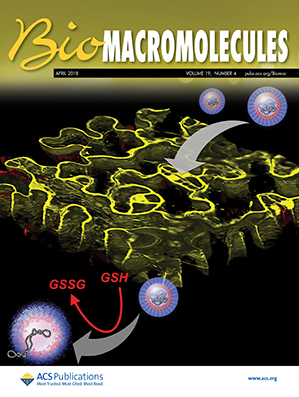3D-Printed Auxetic Ionic Hydrogels with Moisture Retention and High Sensitivity for Sustainable Wearable Sensing
IF 5.4
2区 化学
Q1 BIOCHEMISTRY & MOLECULAR BIOLOGY
引用次数: 0
Abstract
Conductive hydrogels face challenges in maintaining environmental and mechanical stability for practical sensor applications. In this study, a long-term, stable, and highly sensitive ionically conductive hydrogel was developed via a synergistic dual-humectant strategy: glycerol suppressed ice nucleation through hydrogen-bond competition, while LiCl provided dynamic water sorption. This synergy enables unprecedented stabilityremaining unfrozen at −60 °C and retaining 70% moisture over 35 days at 25 °C. The hydrogel exhibits exceptional stretchability (1270% strain) and adhesion (60 kPa) through combined physical/covalent interactions. A three-dimensional (3D)-printed porous architecture enhances sensitivity, achieving a gauge factor of 32 (3 × higher than nonporous hydrogel). In particular, the auxetic-structured conductive hydrogelwhen used as a wearable devicedemonstrated an accurate recognition ability in detecting limb and subtle movements (including speech). These properties position the hydrogels as promising candidates for fabricating flexible wearable sensors with enhanced sensitivity and environmental sustainability.
- Download: Download high-res image (145KB)
- Download: Download full-size image
3d打印的辅助离子水凝胶,具有保湿性和高灵敏度,用于可持续的可穿戴传感。
导电水凝胶在实际传感器应用中面临着保持环境和机械稳定性的挑战。在本研究中,通过一种协同的双湿润剂策略,开发了一种长期、稳定、高灵敏度的离子导电水凝胶:甘油通过氢键竞争抑制冰核,而LiCl提供动态吸水。这种协同作用实现了前所未有的稳定性──在-60°C下保持不冻结,在25°C下保持70%的水分超过35天。通过物理/共价相互作用,水凝胶表现出优异的拉伸性(1270%应变)和粘附性(60 kPa)。三维(3D)打印的多孔结构提高了灵敏度,实现了32的测量因子(比无孔水凝胶高3倍)。特别是,当用作可穿戴设备时,这种助听器结构的导电水凝胶在检测肢体和细微运动(包括语音)方面表现出了准确的识别能力。这些特性使水凝胶成为制造柔性可穿戴传感器的有希望的候选者,具有更高的灵敏度和环境可持续性。
本文章由计算机程序翻译,如有差异,请以英文原文为准。
求助全文
约1分钟内获得全文
求助全文
来源期刊

Biomacromolecules
化学-高分子科学
CiteScore
10.60
自引率
4.80%
发文量
417
审稿时长
1.6 months
期刊介绍:
Biomacromolecules is a leading forum for the dissemination of cutting-edge research at the interface of polymer science and biology. Submissions to Biomacromolecules should contain strong elements of innovation in terms of macromolecular design, synthesis and characterization, or in the application of polymer materials to biology and medicine.
Topics covered by Biomacromolecules include, but are not exclusively limited to: sustainable polymers, polymers based on natural and renewable resources, degradable polymers, polymer conjugates, polymeric drugs, polymers in biocatalysis, biomacromolecular assembly, biomimetic polymers, polymer-biomineral hybrids, biomimetic-polymer processing, polymer recycling, bioactive polymer surfaces, original polymer design for biomedical applications such as immunotherapy, drug delivery, gene delivery, antimicrobial applications, diagnostic imaging and biosensing, polymers in tissue engineering and regenerative medicine, polymeric scaffolds and hydrogels for cell culture and delivery.
 求助内容:
求助内容: 应助结果提醒方式:
应助结果提醒方式:


